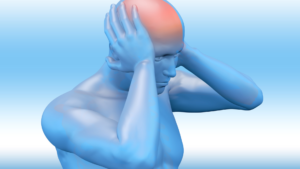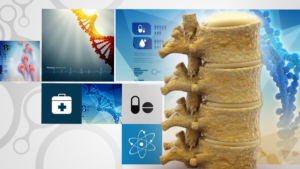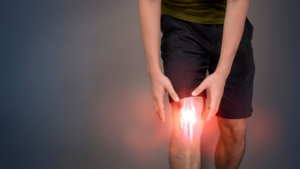Failed back surgery syndrome (FBSS) is the term for a patient’s continued pain after an unsuccessful back surgery. The patient is usually referred to a pain management specialist to treat pain.
The goal of spinal surgery is to decompress a nerve root or to stabilize a painful joint. FBSS occurs when surgery is unsuccessful or negatively affects a structure near the problem area.
Spinal surgery is complicated because it can be hard to diagnose the cause of the pain. X-Rays and MRIs limit what doctors can see because the pain often occurs when the patient is moving and active. Imaging only provides still images.

Failed Back Surgery Syndrome: Signs, Symptoms, and Treatment
Signs & Symptoms of FBSS
One common complaint physicians hear from patients is chronic back pain. However, not everyone experiences the same pain, and the type of pain they experience can vary, based on their spinal disorder, their previous procedure, or underlying cause of FBSS.
Other types of pain that can be associated with FBSS are:
- Nociceptive Pain – Localized pain that may be dull or sharp.
- Neuropathic Pain – Nerve-related pain is caused by nerve or spinal cord damage.
- Radicular Pain – Radicular pain radiates from one area to another
Other common symptoms of Failed Back Surgery Syndrome include:
- Return of original symptoms & pain – When the symptoms return that the original procedure was intended to correct, it may be a sign of FBSS.
- Reduced mobility – Recovering from back surgery is a process. However, if mobility is reduced or limitations arise that are different than predicted by your physician, it could be a sign of FBSS.
- New problems arise – While the surgery may correct the original symptoms, new pain in a different part of the spine should be discussed with your doctor.
- Onset of Headaches – If headaches were not a part of your medical history prior to having surgery, this may be a sign of nerve damage after a spinal procedure.
Diagnosing Failed Back Surgery Syndrome
The first step to diagnosing FBSS pain is to see a doctor for a physical exam. Motion, sensitivity, and strength help doctors decide the next steps to correctly diagnose the pain. Your medical history, pain levels, and previous treatments are discussed with your doctor to help them define the pain and decide on a treatment method.
Having tests like CT scans, MRIs, and X-Rays help doctors take an inside look at your pain. The images don’t always show the root cause of the pain, making FBSS hard to diagnose.
Since imaging is not always reliable, doctors may use another form of testing to diagnose your pain. This is called an aware state surgical examination. A doctor uses a small probe and stimulates the spinal cord, mimicking the pain, and triggering a response from the patient. This informs the doctor what type of pain the patient has and how it is caused.
Back pain patients are referred to pain management specialists who treat their pain and help improve their quality of life through short-term techniques.
Conservative Treatments for Failed Back Surgery Syndrome
There are many conservative treatments for FBSS.Besides the physical therapy and pharmacological therapy with over the counter or prescription medications, doctors use minimally invasive interventional modalities such as epidural steroid injections and injections of the lumbar facet joints or associated medial branches, with or without radiofrequency ablation rhizotomy (RFA).What makes these a consrvative first choice option is the minimally invasive nature of the procedures.These therapeutic interventions are designed to treat the pain and provide temporary symptomatic relief.
Neuromodulation in the Treatment of FBSS
In the treatment of Failed Back Surgery Syndrome, one of the most successful treatment options is Spinal Cord Stimulation. Treatment efficacy for FBSS has increased over the years with the majority of patients experiencing pain relief and reduced medicinal load. Improved quality of life can also be achieved using SCS.
For patients with unrelenting back pain due to mechanical instability of the spine, degenerative disc disease, spinal injury, or deformity, spinal surgery is a well-accepted treatment option; however, even after surgical intervention, many patients continue to experience chronic back pain that can be notoriously difficult to treat. Clinical evidence suggests that for patients with FBSS, repeated surgery will not likely offer relief. Additionally, evidence suggests long-term use of opioid pain medications is not effective in this population, likely presents additional complications, and requires strict management.
SCS has been shown to be a safe and efficacious treatment for this patient population. Recent technological developments in SCS offer even greater pain relief to patients’ refractory to other treatment options, allowing patients to regain functionality and improve their quality of life with significant reductions in pain.
To learn more about FBSS and how the team at Progressive Pain Management can help treat your pain, fill out the form below.
Headaches are a common occurrence in adults. So much so that they are the most frequent complaint doctors hear from their patients. Headaches can be truly painful and debilitating from time to time, but are typically treated with over-the-counter NSAIDs or rest. However, in some cases, headaches can become so severe that medical attention is necessary.
It is important to understand the kind of headache you are experiencing and to know when to seek a doctor’s medical help.
The International Classification of Headache Disorders defines over 100 different types of headaches. Some headaches are caused by underlying conditions (secondary headaches) while others are the main medical concern. Those are called primary headaches, and there are three main types of primary headaches that cause people to seek the help of a doctor.

Types of Headaches
Three Most Common Types of Primary Headaches
Tension Headache
Tension headaches are the most common type of headache – 3 out of 4 adults experience this type of headache. Generally, tension headaches cause a dull pain on both sides of their head, sometimes with a squeezing pressure like your head is in a vice. The pain is usually mild-to-moderate, lasting anywhere between 20 minutes and 2 hours.
Stress and muscle tension, as well as genetics and environment are thought to cause these headaches. Fatigue is also thought to play a role.
Tension headaches are typically treated with over-the-counter medications like acetaminophen (Tylenol) or NSAIDs like aspirin (Aleve) or ibuprofen (Motrin). Always follow the directions on the label as misuse could result in severe side effects to your internal organs. If your headache is mild, a snack or short rest may help.
Migraine
Migraines are less common than tension headaches, but the symptoms are much more severe and intense. This throbbing pain is frequently accompanied by nausea, light sensitivity, and lack of appetite.
Women are 2-3 times more likely to suffer from migraines than men. Neurologists believe that migraines are caused by changes of blood flow to the brain and nerve cell activity, with genetics playing a large role. Many people who experience migraines have one or more family member with the same condition.
Migraines often come without warning and is commonly set off by a trigger. These triggers can vary from person to person. Some common triggers are:
- Changes in weather and humidity
- Fatigue
- Emotional stress
- Sensory triggers like flickering lights, strong smells, or loud noises
- Dietary triggers: chocolate, red wine, MSG, change in caffeine intake
Treatment for migraine headaches depends on the severity of your pain and frequency of this type of headache. Most migraines can be dissolved with over-the-counter medication. Although, if they become severe enough and are debilitating, doctors may prescribe medication for immediate relief, as well as a preventative drug to ward off future migraines.
Cluster Headaches
Cluster headaches are uncommon, but cause sudden onset severe pain that is felt behind the eyes. These headaches are much more severe than tension headaches or migraines and last between 1 to 3 hours. The pain may cause your eyes to become red and watery and eyelids may droop. Nausea may accompany the pain.
They are called cluster headaches because they come in clusters: a person can experience 1-8 headaches a day during a 2-month period every year or so. They typically occur at the same time of year with the pain being the same.
Unlike migraines, cluster headaches are 5 times more common in men than women. While there is no direct cause, they are frequently triggered by alcohol or tobacco use, foods that contain nitrates, or bright light. Certain lifestyle changes are recommended to reduce symptoms and the chances of having onset cluster headaches:
- Quitting smoking
- Prednisone; medication to reduce inflammation or swelling
- Diet changes – limiting food that is high in nitrates like lunch meat or bacon
- Limited alcohol
If those changes do not seem to improve your cluster headaches, doctors may prescribe medications such as lidocaine nose drops, verapamil, or sumatriptan. These drugs are often administered by injection.
If you suffer from any type of headache frequently, you should see a doctor. Frequent, constant headaches may be a sign of an underlying medical condition or lifestyle choice. It is important to work with your doctor and communicate your pain levels and symptoms with your physician so an effective treatment plan can be created.
Oops! We could not locate your form.
Spinal cord stimulation therapy is a pain treatment that masks the pain signal before they reach the brain. A device similar to a pacemaker is implanted in the body and delivers electrical pulses to the spinal cord. This is an option for patients with chronic, leg, or arm pain.
What is Spinal Cord Stimulation?
A spinal cord stimulator (SCS) is a small device that is placed under the skin and transmits a mild, low-frequency electric current to the spinal cord. A tiny wire transfers the pulse to the nerve fibers. The SCS minimizes pain because the current modifies and hides the pain signals from reaching the brain.

Spinal Cord Stimulation for Chronic Pain
It is important to note that spinal cord stimulation therapy does not get rid of the source of the pain. It simply runs interference with the signal to the brain. This means that pain relief can vary depending on the patient. The SCS device produces a slight tingling sensation.. It is this sensation that overrides the pain signals. Pain signals travel on the small nerve fibers, whereas the fabricated signals from the SCS travel on larger, more dominant nerves fibers.
The goal of spinal cord stimulation is not to completely erase pain, but to provide a 50-70% reduction. Even the slightest bit of pain relief can be helpful to someone who suffers regularly. Before a permanent spinal cord stimulator is implanted, each patient undergoes a trial to make sure this type of therapy will be effective and reduce their pain.
Why is SCS Used?
Spinal cord stimulation is used to treat neuropathic pain. This is pain that originates from nerve damage. The nerve damage could be caused by injury, accident, or trauma. Patients who are prime candidates for SCS have typically suffered from chronic pain in the lower back, leg, or arm. Commonly, these patients have also had previous surgeries.
More frequently, SCS is being used to avoid back surgery. Other leading causes for receiving SCS therapy is complex regional pain syndrome and peripheral neuropathic pain. Nerve pain that spans beyond damage to the brain and spinal cord, such as from an infection or even amputation or diabetes, is another reason that SCS may be recommended by your physician.
More recently, SCS therapy has been proven to treat a number of chronic visceral pain types, such as abdominal or pelvic pain.
Spinal cord stimulation therapy is used when other treatment types have not been effective in reducing chronic pain or if the patient does not want to undergo surgery. Fortunately, there are no pre-existing medical conditions that would prevent someone from receiving this type of therapy. If you have pain that is caused by a correctable problem (meaning it could be fixed by having surgery or other interventional treatments), SCS is a viable option for reducing your pain.
This type of therapy is more effective when utilized in the earlier stages of a chronic disease or condition, rather than later when a disability has been established.
SCS therapy is used to reduce these types of pain:
- Failed Back Surgery Syndrome: When initial surgery (or surgeries) have been ineffective in reducing pain on a consistent basis.
- Sciatica or Arm Pain: Persistent pain caused by arthritis, spinal stenosis, or extensive nerve damage.
- Complex Regional Pain Syndrome: When patients experience severe chronic pain, typically in their hands or feet.
- Arachnoiditis: This is painful inflammation and scarring of the protective lining of spinal nerves
Other types of pain caused by stump pain, peripheral vascular disease, multiple sclerosis, or a spinal cord injury may be reduced by the use of a spinal cord stimulator.
Benefits of Spinal Cord Stimulation
Spinal cord stimulation therapy reduces the number of abnormal pain signals from reaching the brain. However, it also helps the body restore pain-inhibition pathways that have been lost. Pain-inhibitory pathways essentially work as a gate-keeper. They control how much pain is received by the brain. SCS therapy harnesses the body’s natural pain-relieving chemicals that are used by nerve fibers to communicate with each other. Not only does this whole process reduce pain, but it increases microcirculation.
It is reported that 50-70% of patients who are candidates for SCS therapy experience 50% reduction in pain. An even higher proportion can expect to experience a 30% reduction in pain levels. For many patients who suffer from chronic pain, even the smallest amount of pain relief is welcomed. This has a profound effect on improving the quality of life in patients who have suffered from long-term chronic pain.
Learn more about spinal cord stimulation and how it works for treating chronic pain, fill out the form below and get in touch with the team at Progressive Pain Management today.
Often, a group of nerves – called a plexus or ganglion – causes pain to an area of the body. This pain can be “turned off” by using a specific injection that blocks the pain signals from reaching the brain. This is called a nerve block.
Nerve block injections are used to treat chronic pain when medications or other treatments prove to be ineffective or cause negative side effects. They allow a damaged nerve proper time to heal, provide temporary pain relief, and can be used to identify a specific cause of pain. Oftentimes, your physician will perform a test block with a local anesthetic. If you have positive results and pain relief from the test block, your doctor will move forward with an injectable nerve block.

Nerve Block Injections for Treating Chronic Pain
Why are Nerve Block Injections Used?
Nerve block injections are used for a variety of purposes. Patients who suffer from acute or chronic pain may receive a nerve block injection for temporary pain relief. Since pain is such an individual experience, nerve blocks are also used to help physicians diagnose the source of pain by measuring the patient’s response to the injection. This is helpful to determine a treatment plan.
Other purposes for nerve blocks are:
- To predict the outcome of any given treatment. Prognostic nerve blocks are performed to determine if a more permanent treatment (surgery) would be more successful in treating pain.
- To avoid surgery, in some cases.
- To prevent additional pain from a procedure or surgery that can cause negative side effects, such as phantom limb pain.
Types of Nerve Blocks
Since nerve block injections can be used for a variety of purposes to help reduce, treat, and prevent pain, it is no surprise that there are many different types of nerve blocks.
The benefit of nerve blocks is that they can be used in almost every area of the body to treat pain. Because of this, there are different nerve block types. Notype of pain should be treated equally. Here are few types of nerve blocks that are available and why they may be utilized in your pain management treatments:
- Therapeutic nerve block: This type of nerve block contains a local anesthetic to control acute pain.
- Prognostic nerve blocks: These are used to help your physician predict the effectiveness and outcome of a given treatment.
- Diagnostic nerve block: This block contains an anesthetic that helps relieve pain and helps pain specialists determine the root cause of chronic or acute pain.
- Sympathetic nerve block: This type of block is used to determine if there is any type of damage or injury to the sympathetic nerve chain – the network of nerves that extends the length of the spine.
- Preemptive nerve blocks: These types of nerve blocks are meant to prevent pain after a surgery that can cause issues like phantom limb pain.
How are Nerve Blocks Performed?
Nerve block injections use imaging guidance – such as fluoroscopy or CT scans – to guide the needle into the injection site. This allows the physician to place the needle in the most accurate location for the injection to be most beneficial. The syringe will be filled with medication, depending on what the patient needs.
A small needle will be inserted through the skin and directed towards the injection site. A small amount of contrast material may be used to confirm needle placement in the appropriate location. The injection itself will be administered with a syringe much like one that would be used for a routine vaccination. The doctor will fill the syringe from a small vial of medication. The type of medication used depends on individual patient needs.
This is typically performed as an outpatient procedure and only takes a few minutes to administer.
Your physician will position you on the table or surface to allow access to the site to be injected. Using imaging guidance, the doctor will identify where the needle needs to be placed. In some cases, more than one injection may be required, depending on the area of pain that needs to be covered. The medication will go into effect rather quickly, but the doctor will have you stay in the office to ensure no immediate and unexpected side effects.
Side Effects and Risks of Nerve Block Injections
Nerve blocks are safe; however, like any procedure and injection, there is always a risk involved. Typically, nerve blocks carry fewer side effects than other types of medication.
Some side effects include:
- Infection
- Bleeding
- Injection site soreness and tenderness
- Bruising
- Damage to nerves
- Elevated blood sugar
- Horner’s syndrome
Nerve blocks provide temporary relief from pain; the results can vary from patient to patient. Speak to your doctor about your options when it comes to relieving your pain so you can determine a course of action. Nerve blocks are among a variety of anesthetics used to treat pain caused by a group of nerves.
Contact Progressive Pain Management to learn more about nerve block injections and how they can help combat your chronic pain. Fill out the form below.
Complex regional pain syndrome (CRPS) is a chronic pain condition that typically affects a limb, like a leg or an arm. Damage or malfunction to the central nervous system is what is believed to cause complex regional pain syndrome. The central nervous system contains the brain and spinal cord. Things like injuries, surgeries, strokes, or heart attacks are common causes.

What is Complex Regional Pain Syndrome
This condition is not common. In fact, it is difficult to diagnose and is historically tricky to treat. The affected area is not only extremely painful but other symptoms can include a change of body temperature, discoloration, and swelling in the affected area.
CPRS can be divided into two types: CRPS-I and CRPS-II. CRPS-I is previously known as reflex sympathetic dystrophy (RSD) syndrome. This type is when patients do not have a confirmed nerve injury or disorder. CRPS-II (also known as causalgia) is when the condition stems from a confirmed nerve injury. Despite there being two types of CRPS, treatments are similar.
Symptoms of Complex Regional Pain Syndrome
The symptoms of CRPS vary. The main symptom that is present is long-term severe pain that may be constant. This pain is often described as burning or a pins-and-needles sensation. Symptoms may change over time, but pain, swelling, redness, and hypersensitivity (allodynia) are typically the first symptoms that occur. Pain has been known to spread, even if the affected area is only a hand or even finger. While this is rare, complex regional pain syndrome may spread to other extremities, such as the opposite limb or other area of the body.
Symptoms can go away on their own, overtime.
Other symptoms of CRPS include:
- Changes in hair growth patterns
- Joint stiffness
- Decreased muscle coordination
- Abnormal sweating pattern in the affected area
- Tremors or jerking of the affected limb
Diagnosis and Treatment Options
Diagnosis
CRPS is diagnosed based on a patient’s medical history and present symptoms. It is especially difficult to diagnose because the symptoms are common to other conditions as well. As a person’s symptoms improve, it is even more difficult to diagnose.
Certain tests are used to rule out other disorders and conditions that display similar symptoms, such as arthritis, Lyme disease, a clotted vein, or a general muscle disease. These tests can provide your physician with clues about what is causing your pain. A careful examination should be performed to determine if an injury is the root cause of the pain – the key feature to CRPS. Thorough examinations help assess the pain and determine if other treatable conditions are present and not ignored.
Imaging tests such as magnetic resonance imaging or triple-phase bone scans may be used to confirm a diagnosis. CRPS is often related to a process where certain cells break down bone and release calcium into the blood. However, this symptom can be caused by other diseases as well. X-Rays are used to show a loss of minerals from your bones. This is common in later phases of the disease. Sympathetic nervous systems tests look for disturbances in your sympathetic nervous system by using thermography to measure your skin temperature and blood flow. Other tests can measure the amount of sweat on your limbs. Irregular results can lead to an accurate prognosis of complex regional pain syndrome.
Treatment Options
The goal of treatments is to lower the intensity of pain and reduce muscle spasms. Your physician may recommend different types of treatment options depending on the severity of your pain and symptoms you experience.
Therapies include:
- Physical Therapy: Physical therapy is used to keep the painful body part moving to increase blood flow. Exercise helps increase flexibility, builds strength, and improves the function of the affected area.
- Nerve Blocks: Sympathetic nerve blocks can provide temporary relief from pain, but does not have any long-term benefits. Nerve blocks involve injecting an anesthetic next to the spine to block the nerves from communicating pain signals with the brain.
- Medications: Various medications are used to help reduce pain. Your doctor may recommend over-the-counter pain relievers such as Naproxen, Ibuprofen, or Aspirin. If a patient is suffering from neuropathic pain, antidepressants may be prescribed. Corticosteroids, such as prednisone, are used to reduce inflammation and improve mobility.
- Heat Therapy: Applying heat may reduce swelling and discomfort on skin that has varying temperatures.
- Biofeedback: Biofeedback techniques help you become more aware of your body so you can train it to relax and reduce pain. This involved being hooked up to an electrical sensors that measure your bodily functions like heart rate. This information helps train your mind and body to understand your pain on a deeper level.
Contact Progressive Pain Management to learn more about complex regional pain syndrome treatment options. Fill out the form below to get started.
Anyone with stiff joints or chronic pain knows how relaxing it can be to slip into a warm bath at the end of the day. This is because the water pressure alleviates the pressure you place on your joints. There is a lot of science behind this buoyant force, and it is the same reason why you feel weightless in water.
When you live with chronic pain, you know that any relief is welcomed. Many pain specialists and physical therapists recommend water therapy for patients with fibromyalgia, osteoarthritis, or chronic joint pain. This does not always mean participating in group water aerobics. Aquatic therapy can also include floating therapy and water yoga.

Aquatic Therapy to Help Reduce Pain
How Aquatic Therapy Helps Ease Chronic Pain
- Water Aerobics for Osteoarthritis
People with osteoporosis benefit greatly from doing water exercises. This allows their muscles to stretch and strengthen using the gentle resistance of water. Stretches like lifting your knees to your chest and using the side of the pool to do leg lifts and arm stretches are good for your muscles and improve your range of motion.
Water aerobics are another type of therapy that prove beneficial for patients with osteoarthritis. Walking in the water, water jogging, and other movements that make your hip joints more limber build strength without having to exercise on a treadmill.
- Floating Therapy
The most simple type of aquatic therapy is floating therapy. This is to simply float. This can be done floating vertically, so that your body is deeply emerged in water. This lets the water pressure have a more therapeutic benefit – the deeper you go, the stronger the pressure. Floating can lower your blood pressure and improve neurological conditions.
Another type of floating that has profound neurological benefits and can aid in relaxation therapy is floating in a super Epsom salt bath. This is a shallow, high-buoyancy tub that focuses on sensory deprivation. Sensory deprivation is a relaxation technique that helps eliminate external stimuli that affects pain.
- Hot Tub Therapy
Patients with back pain regularly find relief from their pain when heat is applied. A take on heat therapy, hot tub therapy combines relaxation from aquatic therapy and the warmth of heat therapy. This also helps patients with osteoarthritis and fibromyalgia. The warm, bubbly water lessens joint stiffness and pain. It also boosts blood flow to the affected area.
Be sure to follow your physician’s recommendations regarding hot tub therapy. The heat can occasionally cause headaches or dizziness, so always follow healthy hot tub regulations.
- Water Yoga
Just like on dry ground, doing water yoga is a well-known rehabilitation technique for patients with chronic pain. However, water yoga adds in a natural resistance. Water pressure encourages deeper, diaphragmatic breathing which is important to the practice of yoga. Yoga is good at preventing muscle soreness, reducing low back pain, and improving neurological conditions. Many yoga stretches are more comfortable when you have the water pressure working against you instead of gravity. It can be easier to sustain the poses and make the poses more effective.
Living with chronic pain is uncomfortable and can prevent you from doing what you love. Easing the symptoms with aquatic therapy can help, but getting the right kind of help from a qualified physician is best. Contact the team at Progressive Pain Management today using the form below.
After surgery, pain is natural. Managing and controlling that pain is crucial to your healing and recovery. More than 80% of patients report pain after surgery. While you should expect some pain after surgery, your physician will take proper precautions and every effort to lessen your pain.
Managing pain after surgery is the most effective way to ensure a healthy recovery. Having a postoperative treatment plan may help reduce the risk of developing complications. When your pain is properly managed, your quality of life will be restored, and essential tasks like walking can be resumed normally.
Post-Surgical Pain Care
Pain after surgery may surprise you. Oftentimes, the painful area is not where the surgery was performed, but instead, referred pain. This means the pain is experienced somewhere other than the affected area. Referred pain occurs because of how pain signals travel along you nerves.

The Importance of Post-Surgical Pain Care
Other types of pain you may experience after surgery are:
- Muscle Pain: Lying in a chair or operating table can result in pain in your neck, shoulders, back, or chest.
- Throat Pain: After surgery, you may experience scratchiness or dryness in your throat. This can make it sore and uncomfortable.
- Movement Pain: Moving and performing important tasks like sitting, walking, and even basic movements like arms and feet can cause pain at or around the incision site or affected area.
Treatment Options for Pain Relief
The goal of pain management after surgery is to relieve an uncomfortable, painful experience and to control pain. However, when there is postoperative pain, you might think the surgery was a failure. Pain after major surgery is to be expected. Your doctor will work with you to determine the best course of action and an effective treatment plan.
Nerve Blocks
Your doctor may recommend a nerve block to control your pain after surgery. Nerve blocks are minimally invasive injections that block pain signals from reaching your brain. This type of treatment helps cut down on the amount of pain medication you will need to take.
Over-the-Counter Pain Medication
Your doctor will likely order over-the-counter pain medications to help relieve your pain after surgery. These medications often include anti-inflammatory medications such as Advil and pain relievers like Tylenol. Over-the-counter medications have minor side effects, if any at all, and are safe to take without the risk of forming an addictive habit. Be sure to follow your doctor’s instructions
At-Home Techniques
There are a number of at-home techniques designed to help relieve pain during recovery.
- Relaxation Techniques: Listening to calming music, biofeedback, and meditation a few of the ways you can relieve your pain at home. Learning to focus your attention on something other than your pain is a natural way to lessen your pain.
- Heat & Cold Therapy: This is an option to reduce swelling and control your pain at home. Your doctor will advise you on how to do this at home. Sometimes only heat, only cold, or an alternating method of both can be effective.
- Exercise: As your healing permits, slowly incorporating low-impact cardio and strength-training exercises help your body reduce pain. Exercise releases endorphins which act as your body’s natural opiate, therefore lessening your pain and discomfort. Exercise should only be done once your doctor has cleared you to resume normal activity. Always consult your physician before beginning an exercise routine.
Regardless of how your postoperative pain is managed, make sure you are comfortable with the treatment plan. Keep open lines of communication with your doctor and nurses to address any concerns or issues that may arise. Stress, anxiety, and miscommunication can all make your pain worse and cause a negative healing experience.
Fill out the form below to contact the team at Progressive Pain Management and learn about treatment options for continual care and pain management.
The field of pain management typically deals with traditional methods for evaluating, diagnosing, and treating various types of acute and chronic pain. However, as more research develops and the field of medicine progresses, physicians are able to learn about the complex intricacies of pain. This has led to a sub-specialty called interventional pain management.
What is Interventional Pain Management?
Conventional pain management treatments such as prescription medications, physical therapy, and other non-invasive techniques help reduce pain. What interventional pain management does differently is that it uses injections and radiofrequency to directly address and treat the root cause of your pain.

What is Interventional Pain Management?
Understanding a patient’s pain, the physiology of pain, and available treatments allows pain management specialists to create a multidisciplinary approach that utilizes a variety of techniques best suited to your pain and lifestyle. Interventional pain management has broadened the scope of technology and treatments that are available, effective, and ultimately able to restore your quality of life.
Types of Interventional Pain Management
Injections like nerve blocks, epidural steroid injections, facet joint injections, neuromodulation, and other interventional techniques are used to treat chronic pain disorders with great accuracy and precision.
Physicians oftentimes will use fluoroscopy to perform the injection. This type of X-Ray guidance allows your physician to see exactly where the injection is being placed in the joint to address the source of pain.
Nerve Block
A nerve block is an injection that is directed towards a specific nerve or group of nerve to treat pain. The injection, an anesthetic or anti-inflammatory medication, blocks the pain signal traveling from that location to your brain, quite literally “turning off” the pain you feel. The block decreases inflammation in the affected area.
Epidural Steroid Injection
Epidural steroid injections are another type of nerve block, but they are injected into the epidural space of the spine. The medication calms the nerve, reducing the painful sensations you feel. Epidural steroid injections are used to treat patients with pain caused by a compressed spinal nerve root, sciatica, and even osteoarthritis.
Facet Joint Injections
Facet joints connect the bones of the spine together, allowing for motion and movement. Inflammation causes pain, and facet joint injections can be used to reduce that pain. These injections are placed alongside the joint, and usually involve a concoction of both a steroid and numbing agent. Patients who have not had success with conventional treatments and suffer from neck, arm, low back, or leg pain that is caused by inflammation of the facet joints is a candidate for this procedure.
Radiofrequency Lesioning
Radiofrequency lesioning reduces pain by preventing transmission of pain signals. Radiofrequency utilizes electrical currents to essentially burn small piece of nerve tissue, creating a long-lasting interruption of pain signals to the brain. This is a non-surgical option to reduce chronic pain
Spinal Cord Stimulation
Spinal cord stimulation (SCS) is a type of neuromodulation that helps treat pain that affects the central, peripheral, or autonomic nervous systems by providing electrical stimulation via implanted devices. A small device, similar to that of a pacemaker, is implanted in the back along the spine. The generator transmits low-voltage electrical currents to the spinal cord instead of pain signals. Patients may feel a slight tingling sensation instead of their pain.
Living with chronic pain is not normal, and patients should know that technology is quickly evolving to provide physicians with the most effective and state-of-the-art treatment options for battling chronic pain. Fill out the form below to learn more about how chronic pain can be managed with an interventional pain specialist. The team at Progressive Pain Management is here to help you reduce pain and improve your quality of life.
People who live with chronic joint pain know how debilitating it can be. Joint pain makes doing daily activities difficult and typically has a negative effect on the quality of life. It can steal away joy from doing the things they love and spending time with loved ones.
Chronic joint pain affects approximately 100 million Americans each year. Fortunately, there are exercises and self-care practices that help reduce and maintain pain. Exercises are designed to reduce inflammation, increase mobility, strengthen joints, and regain range of motion. Ideally, by implementing an exercise routine, there is no need for medication to manage the pain.
Working with a physical therapist or pain specialist is a great way to learn the proper exercise techniques that will help manage and reduce chronic pain. It’s important to remember not to force exercise or continue if it worsens your pain. Listen to you body and do what feels best!

Exercises to Help Reduce Chronic Joint Pain
Always consult your doctor before starting any exercise program.
Types of Exercises to Reduce Chronic Joint Pain
Stretching
Stretching helps relieve tension and stiffness that causes joint pain. Stretching does not require any equipment, so these can be done at-home, on-the-go, or even at work. Stretches are designed for certain areas of pain, like knee pain, neck pain, and back pain.
Cardio
Cardiovascular exercises have a large impact on chronic pain and reducing symptoms that are caused by living with pain. Little-to-no equipment is needed for cardio exercises and they are relatively easy to incorporate into your daily life. Walking is the easiest way to get moving and increase your heart rate, endurance, and strength. If walking is challenging at first, start with short walks and slowly build up the distance overtime.
Swimming and water aerobics are another great cardio option for those living with chronic pain. Being in the water takes the pressure off your joints so you can exercise with ease. This is especially important for patients with low-mobility. Moving in the water adds natural resistance while no additional stress or pressure on your joints is present. Being in the water is often therapeutic, too. Improving your mood is critical to managing chronic pain.
Low-Impact Group Classes
Low-impact exercises are a great way to build muscle strength to better support joints that cause pain. Group setting classes, such as cycling or aerobics, can be beneficial to pain patients. Group classes are usually designed around a certain level of ability, meaning pain patients can take classes that best suit their needs and functions. Group settings are also great for accountability, which is important when trying to exercise regularly.
Cycling, for example, is a smoother motion for the joints than jogging, which can cause further damage and pain. If your pain levels allow, trying cycling a few times a week. The pedaling motions and breathing rhythms are excellent for increasing oxygen flow to the muscles and releasing endorphins that reduce chronic pain.
Balance Exercises
Exercises that focus on balance, core strength, and self-awareness like Yoga, Tai Chi, and Pilates are excellent for managing pain. They improve coordination and balance, which helps increase a sense of where joints are located and how to relieve tensions and pressure on those joints. These exercises include moves that increase flexibility and range of motion. This can loosen joints, which improves their function.
These exercises will help teach proper posture and body positions that align your joints and muscles, in hopes that your pain will be reduced. At Progressive Pain Management, our team can help create a plan incorporating exercise with interventional pain management techniques.
Fill out the form below to learn more.
Lower extremity pain is commonly due to overuse and inflammation as a result of conditions that affect bones, joints, muscles, tendons, and other organs. The key to pain is understanding what causes it. Only physicians can truly diagnose this kind of pain. There are a few questions to ask when diagnosing pain in your legs, hips, thighs, ankles, and lower joints.
- Is there a recent trauma? Falls to the ground are a common cause for lower extremity pain. This is especially true when a patient is unable to recall periods of time or suffers from a drug withdrawal. There is a chance of fracture, so radiographs should be taken.
- Is the pain articular or non-articular? Articular pain (meaning joint pain) is often accompanied by inflammation or swelling. Non-articular pain is musculoskeletal pain and affects muscles and bones. These differentiating symptoms help physicians diagnose the potential source of the pain.
- What is the root of the pain? When determining and understanding the root of the pain, physicians consider a broad variety of symptoms and characteristics regarding your pain. Things like infection, inflammation, vascular, and neoplastic causes can disguise other sources of pain.

Being able to answer those questions helps pain doctors diagnose pain and recommend effective treatments for lower extremities. The term “lower extremities” includes the pelvis and hip joint, thigh, knee, lower leg, ankle, and feet.
Types of Lower Extremity Pain
Ankle
Because your ankle bears the weight of your entire body, it is prone to injury. The ankle is a complex network of bones, tendons, muscles, and ligaments. This means there are a lot of things that can cause pain.
Ankle pain can be caused by a number of conditions, including, but not limited to:
- Achillies tendonitis
- Gout
- Osteoarthritis
- Plantar Fasciitis
- Sprained Ankle
- Stress Fractures
Thigh
Pain in your thigh commonly starts in nerves that surround the hip and radiate down. Muscle pain, nerve pain, and injuries are all factors to consider when looking at thigh pain.
Pain may be caused by:
- Bernhardt-Roth syndrome
- Overuse
- Sciatica
- Peripheral Neuropathy
- Sprained or torn ligament
- Blood clots
Foot
Foot pain can be caused by overuse and conditions that cause inflammation like injury to tendons or ligaments in the foot. Arthritis is a common cause of foot pain. The bottom of the foot has a network of nerves that when damaged, cause immense burning sensations, numbness, or tingling.
Common causes of foot pain include:
- Osteoarthritis
- Mortnon’s Neuroma
- Plantar Fasciitis
- Gout
- Diabetic Neuropathy
- Tendonitis
Lower Leg
Leg pain can be caused by a wide variety of conditions and injuries. Generally, the leg pain is a cause of tissue inflammation. This can be a result of injury or chronic diseases. The leg contains many different types of tissues and bone structures, making injury and pain very common.
Leg pain can be caused by:
- Shin Splints
- Stress Fractures
- Diabetic Neuropathy
- Peripheral Artery Disease
- Sciatica
- Deep Vein Thrombosis
Hip and Pelvis
Hip and pelvis pain can be difficult to diagnose. The movement of the hip joint, lower back, and leg bones are all connected by a large network of muscles, ligaments, tendons, and joints. Pain from another area of the body frequently causes pain in the hip and pelvis region. This is called referred pain.
Sources of pain can include:
- Bone Fractures
- Arthritis
- Nerve Damage
- Muscle Injury or Inflammation
Knee Joint
If you use your knees to repetitively kneel or lift heavy objects, you may experience knee pain. Knee pain affects people of all ages. Injuries are common and regularly affect the ligaments, tendons, or fluid-filled sacs that surround the bone. Cartilage in the knee also gets damaged from normal wear and tear, which can cause pain.
Common causes for pain include:
- Osteoarthritis
- Meniscal Injuries
- Cysts
- Gout
- ACL tears
- Bursitis
Treatment Options
Once a diagnosis has been made, your physician will create a treatment plan specific to your pain. If the cause is musculoskeletal, non-steroidal medications or acetaminophen may be used. If pain persists, stronger medications may be prescribed, although it is rare that narcotics are needed.
If the pain is articular pain, corticosteroid injections may be used to reduce pain. Muscle and tendon pain can be reduced using physical therapy. However, if the muscle pain is due to arthritis, physical therapy may not be helpful.
Your doctor will work with you to create an effective treatment plan that fits your lifestyle and provides the greatest success in restoring a higher quality of life. The team at Progressive Pain Management can help diagnose the underlying cause of your lower extremity pain and find a relief solution. Fill out the form below to contact the team today.

